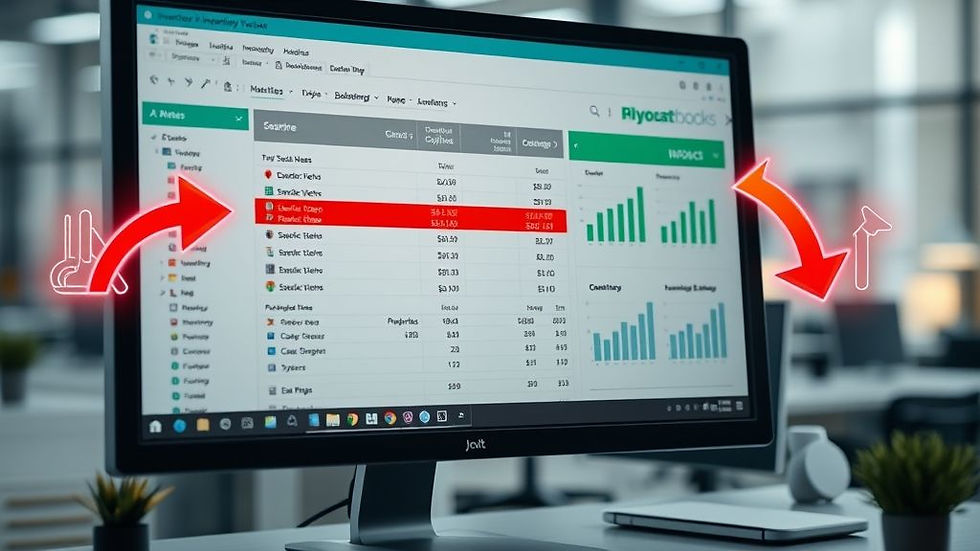QuickBooks Negative Inventory: Causes and How to Repair Them
- quickbooksrepair00
- Sep 11, 2025
- 3 min read

Negative inventory in QuickBooks occurs when your system indicates that you have less stock than you actually hold. This can disrupt financial reports, confuse purchasing decisions, and affect your business operations. Understanding the causes and knowing how to repair it ensures accurate inventory management and smooth accounting.
Why Negative Inventory Happens
Negative inventory usually occurs due to timing or errors in recording transactions. Common causes include:
Selling Before Purchasing
If you sell items before entering the purchase in QuickBooks, the system records a quantity below zero.
Incorrect Item Setup
Using non-inventory items for stock or failing to track inventory properly can cause discrepancies.
Data Import Errors
Importing invoices, sales, or inventory lists with wrong quantities can create negative stock.
Unrecorded Adjustments
Stock adjustments, returns, damaged items, or transfers not entered in QuickBooks lead to negative inventory.
Missing or Damaged Items
Inventory lost, stolen, or damaged without proper updates reduces available stock below zero.
Signs You Have Negative Inventory
QuickBooks makes it easy to spot negative inventory if you know where to look:
Check the Inventory Valuation Summary report. Look for negative quantities or negative total value.
Review the Item List for unusual numbers.
Track recent sales and purchase transactions for mismatched quantities.
Monitor low-stock alerts that appear even when you have enough items.
Step-by-Step Repair Process
Fixing negative inventory requires systematic action. Follow these steps:
Verify Item Types
Make sure each item is set as an inventory part. Non-inventory parts or services do not track quantities.
Check Purchase Records
Confirm that all items sold were recorded as purchased. Match invoices against purchase orders and receipts.
Use Inventory Adjustments
Open Inventory Adjustment in QuickBooks to correct quantities. Adjust for missing, damaged, or unrecorded stock.
Correct Transaction Errors
Identify invoices, bills, or sales orders that caused the negative inventory. Edit quantities or backdate purchases if needed.
Perform a Physical Count
Count actual stock on hand and compare it to QuickBooks records. Adjust quantities to match real inventory.
Reconcile Inventory Regularly
Make it a habit to reconcile inventory monthly. This prevents small errors from turning into negative stock.
Implement Preventive Practices
Record purchases before creating sales.
Enter stock adjustments immediately.
Track inventory items consistently.
Train staff on correct data entry procedures.
Real Example
A small retail business sold 50 units of a product without recording the recent purchase of 100 units. QuickBooks recorded a negative quantity of 50. The owner ran an inventory adjustment to correct the stock and updated the transactions. Regular reconciliation afterward prevented future negative inventory issues.
Why Fixing Negative Inventory Matters
Negative inventory affects multiple areas of your business:
Financial Accuracy
Cost of goods sold and profit margins rely on correct inventory numbers. Negative quantities distort these calculations.
Purchase Decisions
Negative stock can make you reorder items unnecessarily or run out of stock unexpectedly.
Reporting
Inventory reports, tax forms, and balance sheets become unreliable with negative quantities.
Customer Service
Selling items that aren’t actually available can damage customer trust and create order delays.
QuickBooks Features That Help
QuickBooks includes tools to prevent and fix negative inventory:
Inventory Valuation Summary
Provides a clear picture of stock levels and highlights negative items.
Inventory Adjustment Tool
Allows you to add or remove quantities and adjust values.
Reports and Alerts
Low-stock alerts and reports help monitor inventory in real time.
Tips to Prevent Future Negative Inventory
Always record new purchases before selling.
Track inventory with correct item types and categories.
Update stock for damaged or lost items promptly.
Schedule monthly inventory reconciliations.
Train staff to enter transactions accurately.
Final Thought
Negative inventory in QuickBooks is manageable when you identify the cause and take corrective steps. By tracking stock carefully, using inventory adjustment tools, and reconciling regularly, you maintain accurate records and smooth operations. Prompt action ensures reliable financial reports and efficient stock management.



Comments